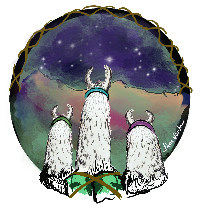Introduction
This is a general guide to the new owners of pack llamas. There is also a selection of trailheads in the Sierra Nevada Range with some Llama specific tips. My hope is to give some guidance in the care and operation of Pack Llamas so as to avoid the pitfalls and mishaps that can occur.
My Brother Russ and I started backpacking in the high Sierra in the early 1970’s. Young and with strong backs, we carried packs that weighed more than 60 pounds over hundreds of miles of trails, never considering that there would be other options that didn’t involve horses.




http://www.packllamasforsale.com/category/artwork/
In the 1980’s, llamas were still a novelty in the United States, relegated to petting zoos and onscreen Pushme-Pullyous. Russ, always willing to take on a new challenge, somehow acquired a male llama in 1982, and this began our experience in the world of llama packing.
In 1991, my wife and I relocated to Portland, Oregon, making a complete restart in our lives. On a whim, we decided to look at ranh property, purchased a six acre parcel with a house south of Portland, and purchased 4 female llamas. Eager to explore the Cascades, we started llama packing all over central and northern Oregon.

Katie and Bud after 28 days on the trail.
At that time, wooly llamas were all the rage. After years of trial and error with training llamas to pack on the trail, we discovered that the classic style of llama–short wool, larger bone structure, made better pack animals. We also discovered that there was an overwhelming interest form other hikers on the trail in our animals–most of the questions came from urban hikers, who loved the idea of using llamas, but had no realistic means of caring for their own.
Moving back to the Sierra Foothills of California in 1996, we decided to embark on a new business venture of renting our llamas, for self-guided llama trips. “Potato Ranch Llama Packers,” on Potato Ranch Road in Sonora was founded. Since then, hundreds of clients have discovered the joy of packing with llamas in the back country. The llamas’ gentle nature, companionship, ease of loading and surefootedness made them perfect trail companions, and now we have had repeat clients make multiple trips over the past two decades.
What is a Pack Llama? The most common term is Ccara. Loose translation “old style”. This is a double coated llama with little wool on the legs, face, ears, and between the ears. Body size and shape can vary 42” to 50” at the withers and 270-400 lbs. For the recreational hikers 42” to 46” is adequate. Leave the taller animals for the outfitters and breeders. Also, the taller animals have a longer stride and go faster. If you are a mature hiker and the glory days are behind you, pick a smaller to medium llama. Llamas are low impact pack animals uniquely suited to the National Park and forest wilderness areas of the United States. They were selectively bred as work animals by the South American inhabitants of the Andes. They are of the Camelid Family, so their food and water requirements are less than traditional stock. They are two toed with a tough foot pad making them very sure footed. Lastly, they are smaller and calmer than horses and mules so that an inexperienced stock handler can travel safely and comfortably for extended periods.
![]()



Recent Comments